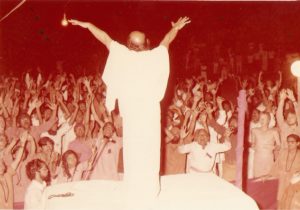Osho – at this time called Bhagwan Shree Rajneesh – begins to initiate seekers into Neo-Sannyas or discipleship, a path of commitment to self-exploration and meditation which does not involve renouncing the world or anything else. Osho’s understanding of ‘Sannyas’ is a radical departure from the traditional Eastern viewpoint. For him it is not the material world that needs to be renounced but the conditionings and belief systems that each generation imposes on the next. He encourages his sannyasins to celebrate life totally rather than abstain from life.
The number of sannyasins grows rapidly, and Osho largely stops accepting invitations to give huge public talks. Instead he begins to devote his energies entirely to working deeply with these new disciples.
He conducts intense 10-day meditation camps where he introduces a number of new, seemingly bizarre, techniques he has developed specifically for the stresses of modern living.
‘It is very difficult for contemporary people to enter directly into meditation, because repressions and inhibitions have accumulated in their unconscious like a rock wall. So I have created cathartic techniques as a preparation for meditation, to remove that rock. Once it is removed, then you can begin the right meditation. There are 112 techniques which you can experiment with to find the one which clicks for you. Those techniques are all variations of one fundamental theme – the foundation that runs through them all is witnessing.’
The 112 techniques are interpreted by him from the ancient Vigyan Bhairav Tantra – Shiva’s 2000-year old tantric Book of Secrets.
In April 1970, he introduces his now-famous revolutionary meditation technique, Dynamic Meditation, which begins with chaotic breathing and uninhibited movement and catharsis, allowing people to connect to and throw off their accumulated stresses and tensions. This is followed by energetic jumping designed to hammer awake unused levels of energy. He says that we have far more energy than we normally use – it just needs to be aroused. This is followed by a period of silence and stillness, where all the energy that has been awakened is turned inside, allowing a peace to descend which creates a distance from the mind and an expansion of consciousness.
This meditation technique is so powerful and successful, it has been adopted by psychotherapists, medical doctors, teachers and other professionals around the world.
In July, 1970, Osho moves to Mumbai, and sets up the first foundation to make his work and vision available – the Jivan Jagruti Kendra Foundation.
There he begins to develop a vision he has long held dear – a revolutionary idea for a totally new kind of society, where communes will replace family, meditation and personal experience will replace religious beliefs, and meritocracy will replace politics. He reasons that people are limited by the ideas and beliefs they unconsciously learn from their families, so it is time to do away with the nuclear family and allow children to have imprints from many adults, especially adults who are meditators, and thus hopefully more conscious and aware.



No Comments Found